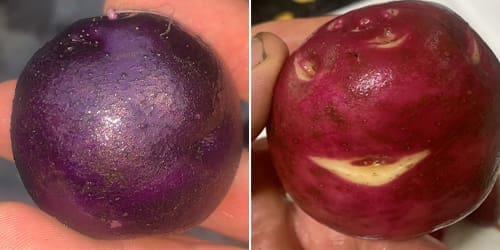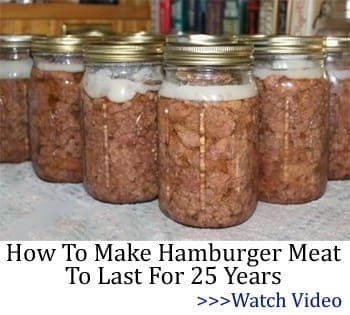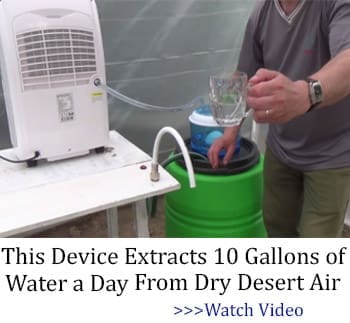Potatoes are a lovely plants to grow, and home grown potatoes taste better than shop spuds.
If you grow your own you can grow and breed potatoes like mine in the picture above. Many people think a potato is a seed itself – the real potato seeds are in fact very different, and this article shows you how to produce real potato seeds, and to use these to produce your own unique, colorful beautiful seed potatoes.
Seed Potatoes vs Potato seeds
People refer to small potatoes as seed potatoes. This is actually factually incorrect. A potato is a stem tuber. A stem tuber is really just a plant stem – so each time you plant a “seed potato” you are really planting a stem cutting and a cloning the mother plant.
Real potato seeds are harvested from potato fruits or cherries -these form above the ground and hang like bunches of tomatoes. Inside the fruit we find hundreds of little seeds. These are real potato seeds.
A few potato cherries from some of my plants. Note how some are purple some are green.

Potato Genetics
Potato genetics are very confusing. So to understand this, lets first take a quick walk back and make it relevant to ourselves.
How We As Humans Work
Each one of us is diploid – this means that we received a set of chromosomes from Mom and Dad. A sperm and an egg fused, and we are half mom, half dad and all shook up by some funny evolutionary tricks, and boom – we have you. Your own unique person. However, you cannot cut your thumb of and plant it and grow a new you. You are not a potato.
How Potatoes Work
Potatoes can be polyploid – i.e., they have more than two sets of chromosomes. So, when Mom potato flower gets pollinated by Dad potato flower (and vice versa) we end up with weird kid potato that can have all sorts of weird combinations of genes. And this is why breeding your own potatoes is so fun. I have had potatoes that I cross pollinated from a purple potato and a red potato come out white with red spots. Or red with white stripes. Or purple. Or white. Or pink. Or oblong and lumpy. And that was just from one potato cherry!

I crossed the purple and red potatoes and this produced the white potato with pink/purple spots.

A few potatoes and the potato cherries I harvested. You can see the seeds in the cherries cut on the top right.

What Is A Potato Cherry/Fruit
Towards the end of a growth cycle potatoes will sometimes send out flowers. These flowers are purple and form in clusters. If they pollinate, they will form little fruit that look like a green tomato. Sometimes this fruit will turn purple, or even pink. Normally they go whitish when they ripen.
How To Select Potatoes To Grow And Produce Fruit
I normally scrounge the organic section in fruit and vegetable stores. In these sections you can find mixed packs of “exotic potatoes”. If you can find long finger shaped ones, these tend to be excellent tasting. Chiloé potatoes are marketed in some areas. These are awesome and crazy potatoes with a lot of genetic diversity.
You can grow these potatoes out in the ground or in pots and let them produce flowers. The flowers will produce potato cherries if you are lucky. And now you have potato seeds!!
How To Prepare The Seeds In Potato Fruit
I find the easiest and most effective way is to rot them. Take a whole lot of fruit and put them in a container. If you add some fruit peels it helps speed them up on the path to rotting. Let them rot. They turn into a mushy slime, which you can then pour through a sieve. The rotting process appears to activate the seeds.
Related: How to Properly Harvest Seeds
How To Germinate The Potato Seeds
I take the fermented seeds and rinse them through a fine sieve – the water washes away all the slime and you will be left with a lot of seeds that look like small tomato seeds. Some will be yellow; some will be black or dark purple.
I take a fine tray of chicken manure compost from my chicken cage – this is a mixture of chicken manure and composted leaves and soil. You can use any potting soil mix that is a bit acidic preferably. If it contains pine bark this helps. If you need to buy a soil, try and buy one formulated for root vegetables such as this.
Potato seeds are quite funny things, and they will either all germinate, or none will germinate. Consequently, I have learned to use a survival of the fittest strategy. Start your first seeds planted very densely in a covered potting tray such as this. I normally plant about 5 or 10 seeds per planting well. If a lot come up, you can always trim the weakest out.
How To Produce Your First “Seed Potato” Tubers
 You can grow the potato plant out in the seed tray as per above. The first cycle of growth never seems to get very big. The plants will grow to the length of a finger or maybe more and will produce one or two small cute little potato tubers the size of peas or marbles.
You can grow the potato plant out in the seed tray as per above. The first cycle of growth never seems to get very big. The plants will grow to the length of a finger or maybe more and will produce one or two small cute little potato tubers the size of peas or marbles.
The first “seed potatoes” you get will be small – the size of a large pea or small marble.
Once you have these first “seed potatoes” you can start to expand them. I plant these into larger pots at this stage. I find that they will come up and grow to produce quite a decent little handful of large marble sized potatoes in the second cycle. This takes about three to four months.
This cycle produces your first “seed potatoes” tubers that you can take to production pots or put into the ground.
 My Mothers potatoes – she grows the ones I grow from seed. The old wine barrels provide an amazing growth space for potatoes and stop moles and mole rats from eating the tubers. She produces much better potatoes than I do and takes the time to do things properly.
My Mothers potatoes – she grows the ones I grow from seed. The old wine barrels provide an amazing growth space for potatoes and stop moles and mole rats from eating the tubers. She produces much better potatoes than I do and takes the time to do things properly.
Your First Production Grow
In this grow our aim is to increase the size of the potato tubers to the point where you can taste a few, and then decide if the strain is worth propagating further. There will be a few nice big potatoes and a whole lot of “seed potatoes” that you can either eat as baby potatoes (if you don’t like the strain) or use to propagate further.
Related: What Happens When You Bury A Fish Head Under A Tomato Plant
Cross Pollination In Potatoes
Potatoes are infernally weird when it comes to pollination. I try to keep an eye out for potato flowers and will then take a little piece of tissue paper and make it a bit damp and rub it on the flowers. If the flower is producing pollen, you can see it on the tissue paper.
I then take this tissue paper and go and wipe it on another flower on a different plant. I have no idea if this transfers pollen at all and if there is any pollination that happens, but I know that when I do this, I get potato cherries, and these seeds come up producing some weird and wonderful potatoes!
A Note On Potato Color And Taste
Potatoes are delicious. The potatoes you produce from seeds will be better than anything you have tasted before because you have this special link with them. Well mostly. Every now and then a miserable awful potato is grown from a seed. You will taste this when you do your first taste test.
I have got so used to our diverse potatoes that it is normal to eat a meal with 6-10 different types of potato in one batch of chips. Sometimes at certain times of year we can go as high as 20-25 different potato types that are available. Every year we add a few extra strains to our collection. I currently have about 20 strains under development.
You lose a few – they die – and a few will get lost by mistake, so for every 20 or so you get going, about 6-10 make it into your collection. I find it takes about three years from seed to big crop for me. You may be able to do it a bit faster if you are diligent. I am not diligent.
You may also like:
If You See This Plant in Your Backyard, Burn It Immediately! (Video)
How To Build An Outdoor Mud Oven










